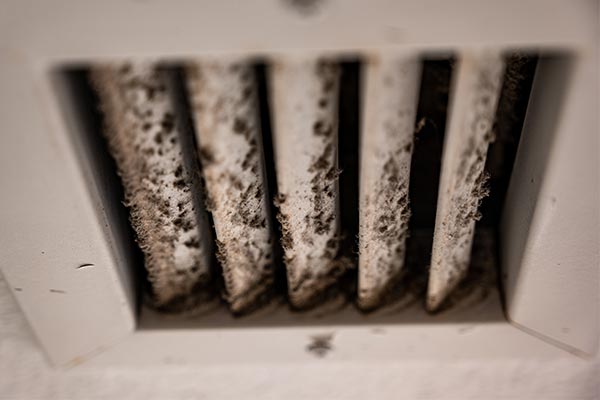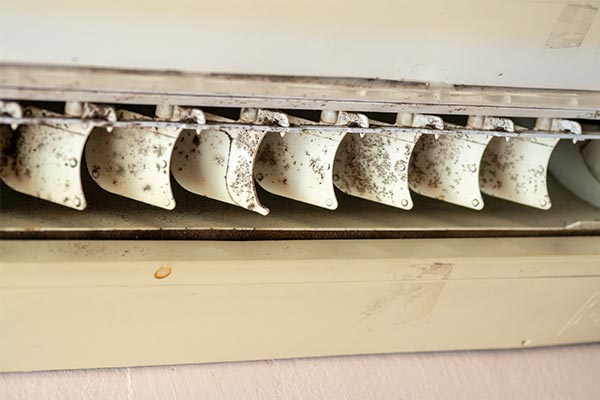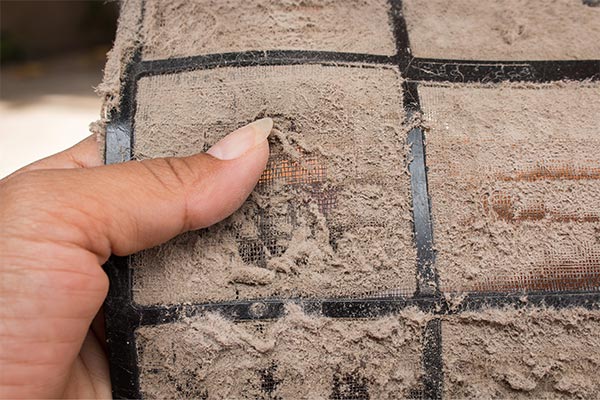In this comprehensive post, we'll go over;
How to Remove Mold from Air Ducts
You'll also learn;
- Preventing Mold buildup.
- Causes of Mold in Air Ducts.
- The common molds that are found in your air ducts.
- Why a professional should do the cleaning.
So if you've ever wondered about any of these points, you'll love this post!

For mold to thrive, two things are needed: warmth, and moisture. An ideal climate for mold to grow would be an area that is warm and humid and is poorly ventilated. Areas like the bathroom, attic, or basement can be more prone to mold growth.
What many people may not know is that air ducts are another space susceptible to mold. Keep reading to find out how mold grows in air ducts, how to prevent it, and how to remove mold in air ducts!
Can Mold Get In Air Ducts?
An HVAC system is made up of various components that allow for heating, ventilation, and air conditioning. Different methods can be used to heat the air that circulates into your home, and an air conditioner is used to cool the air for your home. Whether the air is warm or cool, it will be forced through the air ducts and vents throughout your home.
Since mold needs moisture to thrive, there are some important things to know about your HVAC system and how it works. When your home is being cooled during the hot summer months, the AC unit pulls the air from outside and cools it as it brings it into your home.
The moisture in the air can collect as condensation within the air ducts themselves. If the condensation or water droplets don’t evaporate, they will continue to collect allowing for mold to grow. See below for some common causes of mold in air ducts.
AC unit is too big
If the unit is too big, it can cool a smaller space too quickly not leaving enough time for the humidity to be removed from the air. The moisture can be left to build up allowing mold growth to occur.
Temperature set too low
Supercooled air being forced into warmer air can cause any moisture in the warmer air to condense. If this occurs, moisture will form around the air vents allowing for mold to grown and get into the ducts.
Leaky air ducts
The temperature difference between the warm outside air and the cooled air in the ducts can cause moisture to condense inside the ducts. When mold is within the air ducts, it can be spread throughout your home from the circulated air.
How To Know If You Have Mold In Air Ducts

Initially, it may be difficult to determine if mold is within your air ducts. Mold spores are microscopic, and most often if you can see mold it has already grown into a colony and spread throughout your home. Thankfully, there are other signs to be aware of aside from visual mold spots.
Odors - Mold can produce quite a noticeable musky smell. Most people have smelled mold at some point and can pick out the smell when it is present. If you notice a musky, wet, rotten, or musty odor throughout your home, there could be signs of mold in your air ducts. If the odor is stronger while the AC is running, it is even more likely there is mold.
Visible Mold - Seeing patches of mold in drip pans, around the air vents, or in the ducts themselves. If the mold is visible, surely spores are being spread throughout your home and it is imperative to get it taken care of right away.
Mold In Air Duct Symptoms
There are also health issues that can arise if mold is present in your home. Mold exposure for extended periods can make you quite sick and make pre-existing symptoms worse. Take note if you notice any of the health problems or symptoms below occurring in any people or pets within the home.
*Symptoms are specific to when the AC is running or recently ran*
- Nausea, fatigue, or dizziness when you are home.
- Respiratory effects.
- Headaches.
- Coughing.
- Wheezing.
- Asthma-like symptoms.
- Shortness of breath.
- Pulmonary hemorrhage.
- Allergy-like symptoms such as watery eyes or itchiness in your eyes, irritated sinuses, runny nose, and/or throat irritation which often gets worse when the air conditioner runs.
- Hypersensitivity pneumonitis.
- Infections.
- Sinusitis.
- Hay fever.
How Much Does It Cost To Remove Mold From Air Ducts?
The cost for mold remediation in your air ducts can and will vary. Depending on the severity of the mold infestation within the ducts and the rest of your home, the costs may be significantly higher. Pricing can range anywhere from $500 to $6,000 for full air duct cleaning. Mold remediation for the rest of your home may incur additional costs.
Types Of Mold In Air Ducts
While there are thousands of types of mold, there are some that are more likely to be found within your home.
How To Prevent Mold In Air Ducts

If you have just remedied the mold in air duct issues, it is best to take precautions to prevent the issue from happening again in the future. Check out our list below of what you can do to prevent mold in air ducts.
- Keep vents clean and free from condensation
- Install additional vents in high humidity areas (bathroom, kitchen)
- Be on the lookout for water leaks
- Use a dehumidifier in areas that have more humidity to prevent mold growth
- Keep the drip pans clean
- Insulate air ducts
- Replace HVAC filters
- Install UV light or high-efficiency air purifiers that can kill mold and bacteria.
- Check your ducts regularly for moisture or mold
- Have professional air duct cleaning every few years
Air Duct Mold Removal

Dealing with mold anywhere in your home can be tricky. It is a finicky substance and most regular household cleaners will not effectively kill the mold. In general, it is wise to have a professional come for any mold removal project. Check out the page from the EPA about air duct cleaning.
If you do notice mold on or around your vents, you can create a solution to help prevent more damage or spread while you wait for mold removal specialists from Rock Emergency. Using 1 tbsp of laundry detergent, ½ C of baking soda, and 1 C of water can be combined as a cleaning solution for around your vents.
A bleach solution (1 part bleach to 16 parts water) can be used on the vents themselves. If you decide to try and remove the mold yourself, be sure to wear proper PPE and dispose of it correctly to prevent illness and further contamination.
Why You Need A Professional To Remove Mold In Air Ducts
It may not seem necessary to you to have a professional company like Rock Emergency remove mold from your home. The thing is, regular cleaning won’t fully remove or kill mold and it will keep coming back. The professionals at Rock Emergency have been highly trained to safely and efficiently remove mold from just about anywhere within your home.
Being HAZWOPER trained and IICRC certified, we are the best force to call when you are in need. With 15+ years of experience in the remediation and restoration industry, you’ll only get the best services from us. We’re in this business together, and we are here for you!
Share this Post
